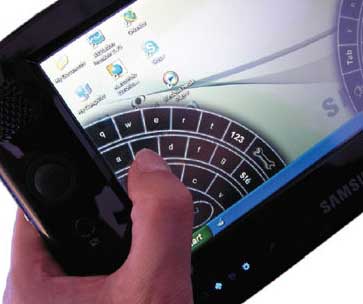Microsoft's Origami officially unfolds today, but it does so amongst a swath of ultra-mobile PC designs. The basics are what we expected: an ultra-mobile or ultra-compact form factor, Windows XP Tablet Edition, wireless (WiFi +Bluetooth), and a touchscreen. Mark your calendar folks, because today is the day that Microsoft is trying to reinvent the PDA. The general specifications are as follows:
- Windows XP Tablet Edition 2005, with Windows Touch Pack
- Intel Celeron M, Pentium M, or possibly VIA C7-M processor
- 128MB of RAM, or more
- 800x480 (minimum) resolution
- 7" (diagonal screen)
- 30GB hard drive, or more (50GB and 60GB to be common)
- US$600-1,000 price tag
- USB inputs

As we suspected, Origami is a "form factor" or a "guideline," and not a specific product. In Microsoft's own words, the Origami design "features small, lightweight, carry-everywhere hardware designs coupled with the full functionality of a Microsoft Windows-based PC and a choice of input options, including enhanced touch-screen capabilities." The latter capabilities come at the hands of the new Windows Touch Pack, which updates the Tablet Edition to include more finger-friendly usage, including a new on-screen split keyboard that is designed for two-hand operation (dubbed DialKeys, pictured right). The Touch Pack also offers an application launcher menu optimized for big fingers and smaller screens, effectively giving the device a different feel from the desktop.
At less than 2 inches deep and about 2 lbs, Origami-based designs are small, but not super small. Their capabilities are big: as Windows PCs, they can do just about anything you can do on a PC, although performance and battery-life considerations should be taken into account. Microsoft and its partners see this device as a consumer electronics product for PC enthusiasts. Rather than try and reinvent the laptop, Origami was designed to be light enough to use casually throughout the home or office, while big enough to outshine smaller products with less capable displays. The end result is a modestly-sized tablet that most consumers will view as a mobile web browsing platform.
Currently three manufacturers are producing devices based off of the Origami design: Asus, Founder and Samsung. Others are expected to join the fray after initial products hit shelves in April, but we expect that caution will be the word of the day as manufacturers attempt to discern whether the concept has legs, or if it will be relegated to the relative obscurity already enjoyed by the likes of other attempts to bring the "PC" to a smaller form factor (e.g., OQO).
Where does Origami improve on previous attempts? The interesting thing about Origami is how similar it is to Media Center Edition. While the two serve entirely different purposes, both are essentially built on top of Windows XP. Not only that, but they both attempt to address user interface limitations in Windows XP the same way: with an application that sits on top of the standard Windows desktop. For Media Center, that meant a UI add-on designed to look good from your couch. For Origami, this means a UI design meant to overcome the problems that the XP UI experiences when it's crammed in a small space. But both products are essentially Windows XP with added ingredients. This strategy fits in nicely with where Windows is headed with Vista, and it shows Microsoft's commitment to getting the underlying technology in place.
Will Origami be a hit? The size is going to be an issue for many users, because it's just not nearly as "ultra-mobile" as its name suggests. Unless you're Shaq, Origami won't fit in your pocket, and you'll never want to travel too far from your charger on account of the relatively short battery life. The screen resolution is also a bit shallow for my tastes, especially when compared to the Nokia 770 Internet Tablet, which crammed 800x480 screen into a much smaller form factor. A good laptop will do a better job of playing video, showing pictures, and displaying documents... but it's not as convenient, I suppose. For sitting around the house or hunkering down for a long flight, the UMPC looks like a decent entertainment device, but it's not without competition. When its time to spend that "disposable income" everyone's talking about, what will it be: PSP, iPod, UMPC/Origami? The list is endless.
In closing, let me just say that it's unfortunate that Origami is going to be yet another decent codename tossed into the wind. It should be embraced and utilized. A year from now "Origami" will still sound elegant, while "PXT1200" or other equally unattractive names will adorn shelves. Perhaps this time around the marketers will figure this out, but I have my doubts.
In the meantime, send review units to the Orbiting HQ.
reader comments